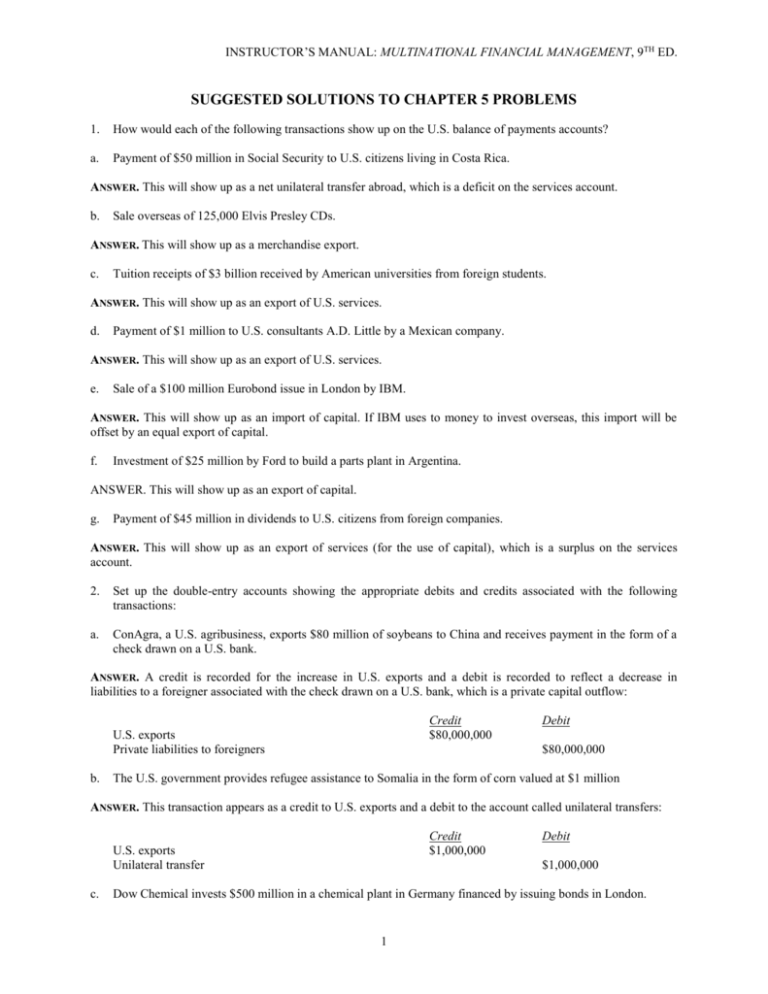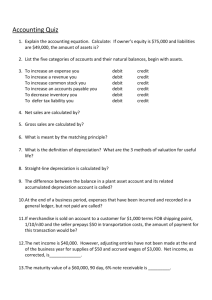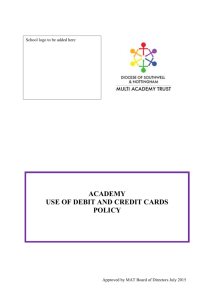CHAPTER 5
advertisement

INSTRUCTOR’S MANUAL: MULTINATIONAL FINANCIAL MANAGEMENT, 9TH ED. SUGGESTED SOLUTIONS TO CHAPTER 5 PROBLEMS 1. How would each of the following transactions show up on the U.S. balance of payments accounts? a. Payment of $50 million in Social Security to U.S. citizens living in Costa Rica. ANSWER. This will show up as a net unilateral transfer abroad, which is a deficit on the services account. b. Sale overseas of 125,000 Elvis Presley CDs. ANSWER. This will show up as a merchandise export. c. Tuition receipts of $3 billion received by American universities from foreign students. ANSWER. This will show up as an export of U.S. services. d. Payment of $1 million to U.S. consultants A.D. Little by a Mexican company. ANSWER. This will show up as an export of U.S. services. e. Sale of a $100 million Eurobond issue in London by IBM. ANSWER. This will show up as an import of capital. If IBM uses to money to invest overseas, this import will be offset by an equal export of capital. f. Investment of $25 million by Ford to build a parts plant in Argentina. ANSWER. This will show up as an export of capital. g. Payment of $45 million in dividends to U.S. citizens from foreign companies. ANSWER. This will show up as an export of services (for the use of capital), which is a surplus on the services account. 2. Set up the double-entry accounts showing the appropriate debits and credits associated with the following transactions: a. ConAgra, a U.S. agribusiness, exports $80 million of soybeans to China and receives payment in the form of a check drawn on a U.S. bank. ANSWER. A credit is recorded for the increase in U.S. exports and a debit is recorded to reflect a decrease in liabilities to a foreigner associated with the check drawn on a U.S. bank, which is a private capital outflow: Credit $80,000,000 U.S. exports Private liabilities to foreigners b. Debit $80,000,000 The U.S. government provides refugee assistance to Somalia in the form of corn valued at $1 million ANSWER. This transaction appears as a credit to U.S. exports and a debit to the account called unilateral transfers: Credit $1,000,000 U.S. exports Unilateral transfer c. Debit $1,000,000 Dow Chemical invests $500 million in a chemical plant in Germany financed by issuing bonds in London. 1 CHAPTER 5: THE BALANCE OF PAYMENTS AND INTERNATIONAL ECONOMIC LINKAGES ANSWER. A debit is recorded to reflect the increase in U.S. investment abroad (the acquisition of foreign assets) and a credit is recorded for the inflow of foreign capital used to finance that investment: Credit Private foreign assets Private liabilities to foreigners d. Debit $500,000,000 $500,000,000 General Motors pays $5 million in dividends to foreign residents, who choose to hold the dividends in the form of bank deposits in New York. ANSWER. A debit is recorded for the importation of services (the use of foreign capital) and a credit is recorded to reflect the increase in liabilities (the bank deposit) to a foreigner, which is a source of funds: Credit U.S. imports (of services) Private liabilities to foreigners e. Debit $5,000,000 $5,000,000 The Bank of Japan buys up one billion dollars in the foreign exchange market to hold down the value of the yen and uses these dollars to buy U.S. Treasury bonds. ANSWER. A debit is recorded to the U.S. private asset account to reflect the purchase of $1 billion worth of yen and a credit is recorded to the U.S. capital account to reflect the Bank of Japan's purchase of Treasury bonds. Credit Private foreign assets Foreign official assets f. Debit $1,000,000,000 $1,000,000,000 CEMEX, a Mexican company, sells $2 million worth of cement to a Texas company and deposits the check in a bank in Dallas. ANSWER. A debit is recorded for the import of cement and a credit is recorded for CEMEX’s U.S. bank deposit, which represents an increase in liabilities to a foreigner. Credit U.S. imports Private liabilities to foreigners g. Debit $2,000,000 $2,000,000 Colombian drug dealers receive $10 million in cash for the cocaine they ship to the U.S. market. The money is smuggled out of the United States and then invested in U.S. corporate bonds on behalf of a Cayman Islands bank. ANSWER. A debit is recorded to reflect the unfortunate U.S. importation of cocaine and a credit is recorded on the capital account to reflect the increased investment in U.S. Treasury bonds by foreigners. Credit U.S. imports Private foreign assets Debit $10,000,000 $10,000,000 3. During the year, Japan had a current-account surplus of $98 billion and a financial-account deficit, aside from the change in its foreign-exchange reserves, of $67 billion. a. Assuming the preceding data are measured with precision, what can you conclude about the change in Japan's foreign exchange reserves during the year? 2 INSTRUCTOR’S MANUAL: MULTINATIONAL FINANCIAL MANAGEMENT, 9TH ED. ANSWER. The sum of the current-account and financial-account balances, aside from the change in official reserves, or $31 billion, must equal the official-reserves balance. Since this figure is positive, it indicates that Japanese official reserves increased by $31 billion, which is a deficit in the official reserves account. This analysis assumes the capital-account balance is zero. b. What is the gap between Japan's national expenditure and its national income? ANSWER. The current-account balance equals the difference between national income and national expenditure. In Japan's case, this identity means the income-expenditure gap is $98 billion; that is, Japan's national income exceeds its spending by the equivalent of $98 billion. c. What is the gap between Japan's savings and its domestic investment? ANSWER. Since national savings- domestic investment equals national income - national expenditure, the answer here is the same as the answer to part b. d. What was Japan's net foreign investment for the year? ANSWER. Japan's net foreign investment equals national savings minus domestic investment, or $98 billion. e. Suppose the Japanese government's budget ran a $22 billion surplus during the year. What can you conclude about Japan's private savings-investment balance for the year? ANSWER. The sum of the private savings-investment balance and the public sector surplus or deficit must equal the national savings-investment balance. With a government surplus of $22 billion and an overall savings-investment balance of $98 billion, the private sector savings-investment balance must equal $76 billion. 4. The following transactions (expressed in U.S. $ billions) take place during a year. Calculate the U.S. merchandise-trade, current-account, capital-account, and financial-account balances. a. The United States exports $300 of goods and receives payment in the form of foreign demand deposits abroad. b. The United States imports $225 of goods and pays for them by drawing down its foreign demand deposits. c. The United States pays $15 to foreigners in dividends drawn on U.S. demand deposits here. d. American tourists spend $30 overseas using traveler's checks drawn on U.S. banks here. e. Americans buy foreign stocks with $60, using foreign demand deposits held abroad. f. The U.S. government sells $45 in gold for foreign demand deposits abroad. g. In a currency support operation, the U.S. government uses its foreign demand deposits to purchase $8 from private foreigners in the United States. ANSWER. U.S. balance of payments accounts Exports a. merchandise: $300 in goods and services Imports b. $225 in goods c. 15 payment of dividends d. 30 in tourist services Balance on current account: + $30 Capital Outflows a. $300 increase in foreign deposits e. 60 increase in U.S. holdings of foreign stocks g. 8 decrease in foreign-owned U.S. demand deposits f. 45 in gold sales Capital Inflows b. $225 decrease in foreign demand deposits c. 15 increase in foreign-owned U.S. demand deposits d. 30 increase in foreign-owned travelers checks drawn on U.S. banks e. 60 decrease in foreign demand deposits f. 45 increase in foreign demand deposits g. 8 decrease in foreign demand deposits Balance on financial account: -$30 3 CHAPTER 5: THE BALANCE OF PAYMENTS AND INTERNATIONAL ECONOMIC LINKAGES There are no capital-account transactions. 5. During the Reagan era, 1981-1988, the U.S. current account moved from a tiny surplus to a large deficit. The following table provides U.S. macroeconomic data for that period. YEAR PRIVATE SAVINGS PRIVATE INVESTMENT GOVERNMENT BUDGET DEFICIT CURRENT-ACCOUNT BALANCE a. 1980 500 468 -35 2 1981 586 558 -30 5 1982 617 503 -109 -11 1983 641 547 -140 -45 1984 743 719 -109 -100 1985 736 715 -125 -125 1986 1987 721 731 718 749 -147 -112 -151 -167 1988 802 794 -98 -129 Based on these data, to what extent would you attribute the changes in the U.S. current-account balance to a decline in the U.S. private savings-investment balance? ANSWER. In 1980, U.S. private savings exceeded private investment by $32 billion. By 1988, this figure had fallen to $8 billion, a change of $24 billion. Over the same period, the U.S. current-account balance went from a surplus of $2 billion to a deficit of $129 billion, a change of $131 billion. Clearly, the change in the U.S. current-account balance is only minimally attributable to the change in the U.S. private savings-investment balance. b. To what extent would you attribute the changes in the U.S. current-account balance to an increase in the U.S. government budget deficit? ANSWER. Over the period 1980-1988, the U.S. current-account balance tracked the U.S. government budget deficit much more closely than did the U.S. private savings-investment balance. This relationship can be seen in the following chart, which is based solely on the data presented in the previous table. -100 Based on these data, what was the excess of national spending over national income during this period? ANSWER. Using the identity national income - national expenditure = balance on current account, we can answer this question by summing the current-account balance over this nine-year period. The sum is -$721 billion, indicating that over this period, the United States spent $721 billion more than it earned. 4







